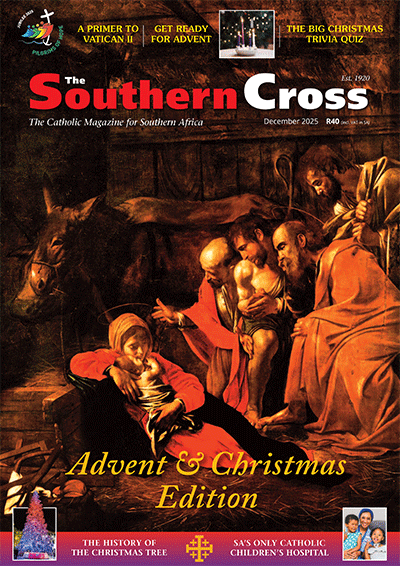The Church in the Modern World

Then-Bishop Prevost on horseback, sometimes the only mode of transport to reach remote areas of his diocese in Peru. (Inset) Pope Leo XIII in a colourised 1887 photo.
About 60 days ago, some 133 cardinals were meeting in conclave in Rome to choose our new pope. And 60 years ago, a much larger group of bishops — over 2500 — were also gathered in Rome to consider what the relationship of the Church should be with the modern world.
The result of their deliberations, the Vatican II document Gaudium et Spes (Joy and Hope), has had a definitive influence on every papacy since then. It already looks as if it will be a touchstone for Pope Leo XIV.
I believe that most of us — lay people, religious, priests and bishops — have still failed to take seriously the challenge that Gaudium et Spes lays out. That challenge is hidden in the use of one very small preposition in the English version of its sub-title: “The Pastoral Constitution of the Church in the Modern World”.
What we should note is that it is the Church in the modern world — not alongside, not outside, not against, not even with — but in. The air that the Church breathes — because it is the air that we all breathe — is the air of the Modern World.
The inspiring Leo
The challenge this sets us is one that our new pope is clearly keen to embrace. His very first papal act in choosing a name has indicated his course very clearly. There have been a number of popes named Leo who might have inspired him — 13 to be precise. Six of them had reigns of under three years, two of more than 20 years; one confronted Attila the Hun while another crowned Charlemagne as emperor; some managed to avoid schisms, whereas two probably precipitated splits in the Church, between East and West, and within the Western Church. But the new Leo made it clear that it is the most recent Leo that inspired him.
Leo XIII was the pope for nearly all of the last quarter of the 19th century. It was a time of great turmoil, with political, economic, social and psychological movements that brought great change, and larger-than-life national leaders trying to control the course of events.
What is more, new technologies were emerging that would have an enormous effect on how people engaged with each other — both film and radio emerged during his papacy, as did the motor car. If all the threats and opportunities of emerging technologies sound familiar to us today, you can see why Leo XIII would be an appropriate inspiration for Robert Prevost.
But it is for one particular document that Leo XIII is most remembered, an encyclical in 1891 entitled Rerum Novarum. This is regularly cited as the foundation of modern Catholic Social Teaching, so much so that later papal encyclicals were issued to mark its 40th, 80th and 100th anniversaries.
At a time when debates were raging across Europe between capitalism and Marxism, Leo XIII stepped into what could have been a quagmire. And he responded with a beautiful and balanced reflection that defended private property while also upholding the value and dignity of labour.
Those who think this already sounds too political will be shocked to hear that the document covers such details as strikes, working hours, the duties of the state, statutory leave, just wages, the right to work, unionisation, and health and safety. Leo XIII was not content to offer general platitudes or broad theories — he felt that the Church should have concrete opinions on these issues and should not be afraid to voice them.
‘Political’ popes
It is this willingness to venture into “secular” areas that set the definition of Catholic Social Teaching. And every Pope since Leo XIII has gone “where angels fear to tread”. Sometimes what they have said is prophetic, well-informed and enduring; sometimes perhaps less so. But what Leo XIII established was the courage to speak to the world about some of the questions that really matter in the world. Gaudium et Spes brought this to a logical summit.
Of course, there will be inevitable clashes, misunderstandings and disagreements of emphasis when the Church holds forth on such subjects. That is because she is drawing on the resource of the Gospel and ancient traditions that others might overlook. But to ensure that what the Church says is connected to the wider discourse, she also can and should draw on the latest in the sciences and the social sciences.
We can be hopeful that Leo XIV will do so since, like his immediate predecessor, he has a background in science that balances his theological and philosophical studies. In this regard, Leo XIII also set a good example by embracing the need for science and religion to co-exist. He said he was re-establishing the Vatican Observatory “so that everyone might see clearly that the Church and her pastors are not opposed to true and solid science, whether human or divine, but that they embrace it, encourage it, and promote it with the fullest possible devotion”.
If she chooses to, the Church can also draw on human experiences, at every level and from every part of the world. This is the principle of synodality that Francis encouraged and Leo XIV has embraced. Not the superficial knee-jerk of politicians who are reacting to the latest opinion poll, but the considered and thoughtful reflections of pastors who know their flock and live alongside them, sharing their lives and their concerns.
Put your boots on
There is a lovely parallel that both Leo XIV when a bishop in Peru, and Leo XIII when a bishop in Perugia in Italy, had to help their communities deal with devastating floods and, to use a favourite image of Francis, they rolled up their sleeves and put their boots on.
We can be hopeful then that in Leo XIV we have a pope who will not be afraid to respond to some of the pressing issues of our times, and that he will have the self-awareness to listen to the voices of experts in various fields and to those of people whose lives are affected.
So can we sit back and relax? Not at all. Whereas Rerum Novarum was addressed only to the bishops, most subsequent documents of Catholic Social Teaching have been addressed to all members of the Catholic Church and sometimes to “all people of goodwill”.
The challenge to engage with the world is one that falls on each one of us: lay person, priest and bishop. It should impact on how we treat a domestic worker, how we spend our money, how we take care of the environment, how we respond to the manifest inequalities in our society. Leading from Rome, Leo XIV can, in continuity with his predecessors, set us a good model and lay down specific challenges. But to call ourselves Catholics, we need to respond.
“The Pastoral Constitution of the Church in the Modern World” was intentionally presented by Vatican II with the same weight as Lumen Gentium, “The Dogmatic Constitution of the Church”. That means that our external focus on the world and its needs should be equal to our internal focus on liturgy, ritual and Church management. Leo XIV has indicated that he is equally concerned about both.
But what happens when we think about our own diocese, our own parish, our own lives as Catholics? Where do we invest our time? Where do we spend our money? Does our faith give us the courage to live in, to learn from and (when needed) to challenge the Modern World? Or do we use it as an excuse to escape from or ignore the Modern World? Do we build bridges, or do we erect walls?
- Pope Leo’s First Teaching - December 8, 2025
- Are We the Church of the Poor? - November 15, 2025
- Fraternity Across the Lines - October 30, 2025





